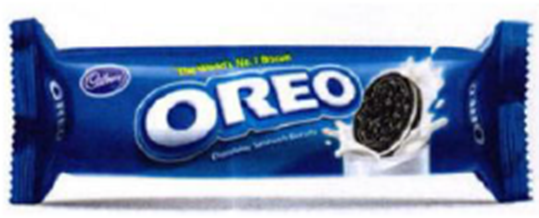Delhi High Court restrains Parle’s use of FABI!O brand and similar trade dress to OREO
Dispute arose between Intercontinental brands and Parle over the mark FAB!O, when Parle in or around January, 2020, introduced its range of vanilla cream filled chocolate sandwich biscuits under the brand FAB!O. Prior to 2020, Parle was using the brands FAB and FAB! for biscuits.
Facts and Background
Intercontinental Great Brands (Intercontinental) the owner of OREO brand of biscuits sold in a distinctive  packaging has brought trademark infringement and passing off suit against Parle Product Private Limited (Parle) alleging that:
packaging has brought trademark infringement and passing off suit against Parle Product Private Limited (Parle) alleging that:

- The mark FAB!O (though written with an exclamation for letter I) is bound to be pronounced as FABIO which is deceptively similar to OREO.
- The design of the FAB!O
 biscuit infringes the design of the OREO cookie
biscuit infringes the design of the OREO cookie  , in which Intercontinental holds a subsisting trademark.
, in which Intercontinental holds a subsisting trademark. - The trade dress of the package of the FAB!O biscuits is also deceptively similar to the OREO biscuits package.
- a blue and white colour scheme with an overall blue background
- slanted placements of the OREO and FAB!O words on the pack
- the words OREO and FAB!O written in white letters with a blue outline
- similar size of the packages
- Intercontinental, is the registered proprietor of the mark
 both word and device marks under which they sell cream-filled sandwich biscuits. They also use a distinctive packaging
both word and device marks under which they sell cream-filled sandwich biscuits. They also use a distinctive packaging  to sell Oreo branded biscuits.
to sell Oreo branded biscuits. - Parle’s FAB!O mark discloses an intent to imitate. This is evident from the fact that they use the FAB!O mark only for the category of biscuits sold under the OREO mark, i.e., vanilla cream filled chocolate sandwich biscuits. Thus, the intent to imitate the OREO brand of biscuits and to capitalize on goodwill is transparent.
Parle countered the arguments submitting:
- There is no phonetic similarity between OREO and FAB!O. The only common letter in the rival marks is ‘O’.
- FAB!O as used by Parle is structurally, visually and phonetically dissimilar to OREO.
- The packings in which OREO and FAB!O biscuits are sold are common to the trade. The use of the house mark
 further negates any chances of confusion. When the individual elements of the rival packings are common to the trade, there, can be no question of deceptive similarity on the basis of overall appearance of the packs.
further negates any chances of confusion. When the individual elements of the rival packings are common to the trade, there, can be no question of deceptive similarity on the basis of overall appearance of the packs. - FAB!O mark is merely an amalgam of the FAB! and FABO marks. The exclamation mark was added to incorporate a fun element and make it unique vis-à-vis other marks.
Court’s findings
- Though Parle has stylistically written its mark as FAB!O, the ‘!’ is merely an ‘I’ in disguise, borne out from its promotional material. The ‘i’ in Fabio has, thus, been made to stand on its head and metamorphose into an exclamation mark, only to depict the mark on the biscuit packs as ‘FAB!O.’ Whatever the purpose of interspersing between FAB and O, the exclamation mark, the advertisements of Parle contain unambiguous representations that the mark is actually ‘FAB!O’ and nothing else.
- Whether OREO and FABIO are phonetically similar, the Court noted the manner in which Parle, in its advertisements, had declared that its FAB!O mark is required to be pronounced as ‘fabee-yo’ amounts to a clear acknowledgment that FAB!O is to be pronounced like OREO, which would be pronounced-ee-yo’. Parle can hardly contend that FAB!O and OREO are not phonetically similar in the scenario.
- It is relevant to note that FAB!, regardless of the exclamation mark, has a laudatory meaning, whereas FAB!O has no meaning. Considering that Parle uses FAB!O only in cream-filled chocolate sandwich biscuits, and the blue package is used only for vanilla cream-filled chocolate sandwich biscuits, it is evident Parle has consciously sought to come as close to the OREO mark. Moreover, Parle has not explained its decision to add an ‘O’ to its existing FAB! mark, specifically for cream-filled chocolate sandwich biscuits. Given all the similar features between the two packs in which the two cookies are sold, the likelihood of a customer presuming an association between the FAB!O and OREO brands looms large.
- With regard to Parle’s contention that the trade dress is common to the trade, it is relevant to note that commonality is not a defense against infringement. Merely citing third parties using trade dress similar to OREO will not suffice to hold that it is common to the trade, and moreover, no evidence is forthcoming in that regard.
- A comparison of the surface designs of the FAB!O, and OREO biscuits shows that it is dissimilar, and no infringement will lie in that regard. As biscuits are not sold loose, no passing off also will lie on the basis of similarity in surface designs.
In light of the above findings, the Court restrained Parle from using the mark FABIO or FAB!O and the impugned trade dress till the disposal of the suit.
Please follow and like us:



